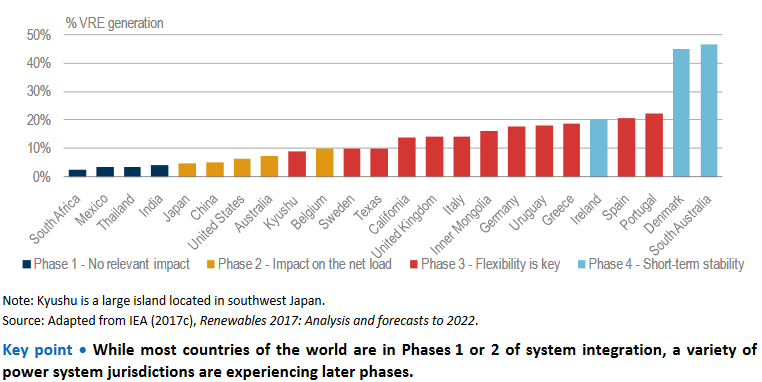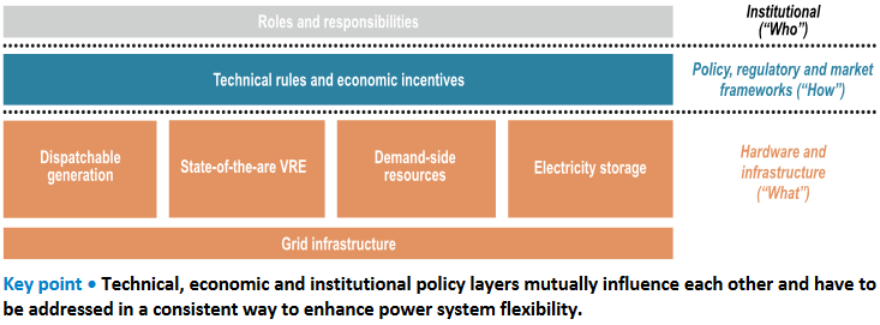Flexibility and the grid
The challenges raised for the grid and dispatchable generation by the South Australian “experiment” are also being faced by other countries and power systems internationally.
Renewable energy across the globe has grown rapidly over recent years. Solar PV experienced record global deployment in 2017, and falling costs for wind and solar energy along with government policy support have helped to fuel the growth of renewable energy across the globe.
However the intermittency of renewable energy creates challenges around security of supply and how to ensure continuous and stable power. “Keeping the lights on requires the continuous balancing of supply and demand across all timescales, from moments to years”.[i] And the challenge of integrating large-scale renewables is further complicated by greater decentralisation of energy sources like solar PV, “smart loads such as electric vehicles, and the spread of digitalisation”[ii].
The need to develop greater power plant flexibility has become a global priority according to a new International Energy Agency (IEA) report, Status of Power Systems Transformation – Advanced Power Plant Flexibility.
The report recognises that there is a shift in the role of dispatchable power stations, stating:
“Historically, baseload, intermediate and peaking plants helped meet specific segments of electricity demand at least cost by providing the appropriate mixture of energy and capacity. These plants were designed, from a technical standpoint, with these specific operating conditions in mind. From an economic standpoint, the plants were financed under the expectation of a certain number of operating hours. Today, as a new generation of technologies with distinct cost structures and technical characteristics enter power markets at scale, many existing power plants are being asked to operate with greater flexibility, and in some cases for a reduced number of operating hours.”
The IEA argues that faced with the current energy transformation, “policy-makers and other power-sector stakeholders need a co-ordinated and proactive response to managing these market changes and ensuring electricity security in modern power systems”.
Responses can range from modifications in the operation of existing power plants to adding new generators to the grid to provide additional flexibility capabilities. The report highlights that significant new capital investments are not necessarily required to operate power plants more flexibly.
“Indeed, low-cost improvements can easily be achieved by changes to operational practices for existing power plants, like better monitoring and control equipment.
“Flexibility of power plants can also be improved by a range of retrofit options or state-of-the-art flexible power plant technologies,” the report says.
It recognises that what might work best for the system overall may impact individual power stations. Under these circumstances public policy can help bridge the gap between system needs and individual plant operations to maintain profitability under an increasingly flexible operating environment. Options include policy, market and regulatory instruments.
Phases of Integration
The IEA has identified six phases of integrating variable renewable generation into the grid and managing system flexibility. Countries can be categorised according to their deployment phase.
Phase 1: Insignificant levels of VRE.
Phase 2: Changes between load and net load become noticeable. Upgrades to operating practices and making better use of existing system resources are usually sufficient to achieve system integration.
Phase 3: Greater swings in the supply-demand balance prompt the need for a systematic increase in power system flexibility that goes beyond what can be fairly easily supplied by existing assets and operational practice.
Phase 4: The output from renewables can provide a large majority of electricity demand during certain times, which requires changes in operational and regulatory approaches. Operationally it involves managing system stability, while from a regulatory aspect it could involve rule changes to require renewables to provide frequency response services.
Phase 5: Adding more renewables means their output frequently exceeds power demand, leading to a risk of curtailment of renewable output. In this period renewables can at times meet all demand. Shifting demand to periods of high renewable output and creating demand via electrification can help mitigate the issue. Another option is to enhance interconnection.
Phase 6: The main hurdle to even higher levels of renewables becomes meeting demand during periods of low wind and sun availability – it can be characterised by the potential need for seasonal storage and use of synthetic fuels (e.g. hydrogen).
The phase also depends not only the level of renewables in the system, but also the other characteristics of the local grid. The report points to South Australia and highlights that while overall Australia has a generally lower share of renewables, South Australia has a very high penetration and faces phase 4 type issues.
Figure 1: Selected country by phase, 2016

Source: IEA
Most advanced countries are primarily having to contend with issues in phase 3, while the vast majority of countries are still in phases 1 and 2.
Figure 2: Different aspects to support flexibility

Source: IEA
The IEA argues that the flexibility of a power system is determined by “the hardware and infrastructure available (the “what”), the policy, regulatory and market frameworks (the “how”), and the institutional roles and responsibilities of entities providing flexibility (the “who”) – and all three aspects must work in concert to support system flexibility (Figure 2).
The IEA report can be found here.
[i] Status of Power System Transformation, IEA, May 2018
[ii] ibid
Related Analysis
International Energy Summit: The State of the Global Energy Transition
Australian Energy Council CEO Louisa Kinnear and the Energy Networks Australia CEO and Chair, Dom van den Berg and John Cleland recently attended the International Electricity Summit. Held every 18 months, the Summit brings together leaders from across the globe to share updates on energy markets around the world and the opportunities and challenges being faced as the world collectively transitions to net zero. We take a look at what was discussed.
Great British Energy – The UK’s new state-owned energy company
Last week’s UK election saw the Labour Party return to government after 14 years in opposition. Their emphatic win – the largest majority in a quarter of a century - delivered a mandate to implement their party manifesto, including a promise to set up Great British Energy (GB Energy), a publicly-owned and independently-run energy company which aims to deliver cheaper energy bills and cleaner power. So what is GB Energy and how will it work? We take a closer look.
Delivering on the ISP – risks and opportunities for future iterations
AEMO’s Integrated System Plan (ISP) maps an optimal development path (ODP) for generation, storage and network investments to hit the country’s net zero by 2050 target. It is predicated on a range of Federal and state government policy settings and reforms and on a range of scenarios succeeding. As with all modelling exercises, the ISP is based on a range of inputs and assumptions, all of which can, and do, change. AEMO itself has highlighted several risks. We take a look.
Send an email with your question or comment, and include your name and a short message and we'll get back to you shortly.



